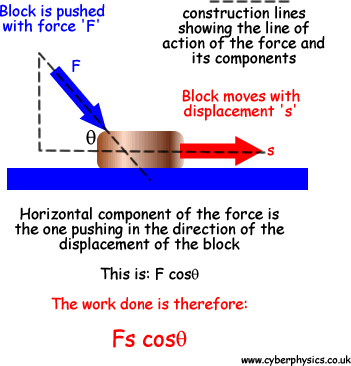Work done by a force 'Work done' is the energy transfer when a force acts on an object. It is measured in joules (because it is a form of energy). Work done = Fs Where
At GCSE you will not be given a force and displacement vector at an angle to each other other than 0o, but at A Level you will.... We then have to bring Cos θ into it where θ is the angle between the force and the direction of movement - you will also then use the symbol 'W' for work and the symbol 's' for displacement - as it is displacement in the direction of the foce only that counts as work! You therefore have to resolve a force at an angle into that force and the one at perpendicular to it to solve the problem. W = Fs cos θ
Efficiency of a system:In machines and systems that we design to 'do work' for us, we have to put in energy or 'effort' in order to get the machine to do work on the task or 'load'. No system is 100% efficient We always have to put in more work as effort than the machine produces for us as useful work done on the load. This is because of frictional forces, or electrical heating effects etc. The effort has to work against them as well as against the load.
Useful links: |
Follow me...
|







